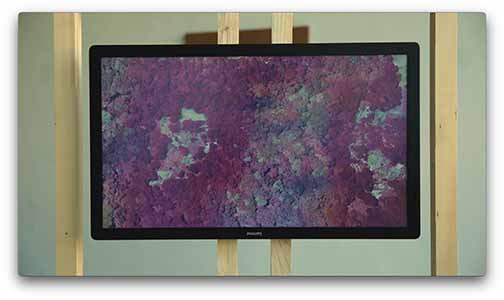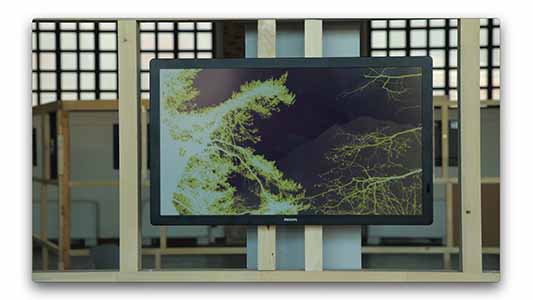Amsterdam: PPDS, the exclusive global provider of Philips professional displays and dedicated AV software solutions, is delighted to announce that British art collective, C-LAB, has been named the inaugural winner of PPDS’ sustainability-driven MUSE Digital Art Award competition, receiving €3,000 in cash and a ‘zero power’, full colour, Philips Tableaux ePaper display.
Launched in August, the MUSE Digital Art Award from PPDS is a new and highly unique cultural initiative designed to connect the world’s most creative artistic minds with leading sustainable display technology.

Working in partnership with renowned contemporary art curator, Julia Rajacic, and supported by Italy’s National Museum of Digital Art (MNDA), PPDS invited professional and aspiring artists from around the world to use their creative skills to visualise some of the challenges posed by the global ecological and climate crisis faced today and tomorrow, to inspire a better future.
Reframing the future
Exceeding all expectations, PPDS received over 200 entries from 44 countries and spanning all continents, with 20 finalists being selected by an esteemed panel of professional judges from throughout the art world. These included Ilaria Bonacossa (director of the MNDA), Domenico Quaranta (writer, curator, and art critic, co-founder of Link Art Center), and Gabriela Galati (art critic and curator, director of the IPERCUBO gallery).
With Milan selected as the host city for MUSE, each finalist – including 17 professional artists and three local art students – had their entries prepared and delivered onto 20 x individual Philips Tableaux displays, which were then installed in Milan’s notorious Fabbrica del Vapore cultural venue, for what is being hailed as world’s first, ‘zero power’ digital art exhibition, which opened on 23 November 2023, running until 12 December 2023.
Sustainability being pivotal to the concept of MUSE, the 25” Philips Tableaux ePaper display was selected due to its capabilities of delivering a vivid image, 24/7, while running entirely unplugged and without using a single kilowatt of electricity*. In addition, MUSE has been conducted under strict carbon neutrality guidelines, with a carbon footprint report also being produced and published, taking into consideration staff transportation, material packaging, shipping, energy consumption, and printing, enabling any carbon to be offset by local Italian sustainability company, Ustainable.
Worthy winners
In a special public PPDS hosted awards ceremony at the Fabbrica del Vapore on 23 November, the judges gathered to determine an overall winner, with ‘Living Dead — On the Trail of a Female’, a project by Laura Cinti in collaboration with Debbie Jewitt and Howard Boland, scooping the €3,000 cash prize and a Philips Tableaux ePaper display.
Laura is the co-founder and co-director of C-LAB, a London-based transdisciplinary collective that uses unconventional materials and emerging technologies to create unique art experiences. Installations combine the use of software, hardware and biotechnology.
Giacomo Erba, a Milan-born twenty-two-year-old visual artist attending the New Technologies of Art course at the Accademia di Belle Arti di Brera, was named winner of the MUSE Student Award, also receiving a Philips Tableaux and special mention for his work ‘Gneiss/3 ore/°1200°, 2022, Digital photography’. Details on each winning entry can be found below.
Ron Cottaar, Director of Global Marketing at PPDS, said: “At PPDS, we are proud to be leading from the front in bringing new, more energy conscious display solutions for businesses everywhere, supporting their journey to operate more sustainably. And as a business we look far beyond simply the sale of products. We want to help influence change, so with the creation of MUSE, along with our Philips Tableaux and their ability to show art without the need for printed paper, we believe, and hope we will inspire the world to be better.”
Stefan van Sabben, Global CSR and Sustainability Manager at PPDS, concluded: “The magnitude of challenges posed by the global ecological and climate crisis require urgent and decisive action and commitment, with researching and asserting new ways of thinking and acting crucial to achieving change. Initiatives like MUSE are a perfect opportunity to help provide new ways of illustrating and inspiring transformation – as individuals, organisations, and whole communities, while connecting and showcasing those visions with sustainable technology.”
Luca Guariniello, Marketing Manager Italy at PPDS, concluded: “The response to MUSE has been nothing short of incredible. The concept immediately caught the imagination of the art world, and the entries we received were at a standard we simply couldn’t have imagined. I’d like to thank everyone for their hard work, time, and commitment in making this competition and event such a resounding success. My congratulations to everyone who entered, and of course, to our very worthy winners.”
Video highlights of the exhibition can be viewed here.
Winner of the MUSE Digital Art Award: Laura Cinti (C-Lab)
The artwork: Living Dead — On the Trail of a Female, 2022, Drone Photography
Project: No longer existing in the wild, ‘Encephalartos woodii’ is one of the rarest and most endangered plants on Earth. One male specimen was found in 1895 in the Ngoye Forest, South Africa. It was removed from the wild and its offsets have been propagated in botanical gardens worldwide. However, these specimens are all clones of the original male. Numerous expeditions have sought to find another specimen, specifically a female, to bring ‘Encephalartos woodii’ back from the brink of extinction, but so far without success.
The Ngoye Forest hasn’t been fully surveyed and there is a possibility that a female may exist. Searches were conducted using a drone equipped with a multispectral sensor. This is the first time these methods have been used to search for ‘Encephalartos woodii’. The story of this enigmatic cycad, its discovery, and subsequent disappearance from the wild, highlights the importance of conservation efforts in preserving the planet’s rich diversity of life and is a poignant reminder of the fragility of biodiversity.
More info: www.c-lab.co.uk/projects/living_dead
Winner of the MUSE Student Special Mention: Giacomo Erba
The artwork: Gneiss/3 ore/°1200°, 2022, Digital Photography
Project: The artwork represents a mountain landscape in late spring. The file was taken with in-camera post-production, using functions of a digital reflex camera with a mirror. The camera body, which is 15 years old and primarily intended for amateur photography, is now outdated compared to current mirrorless cameras (whose sensors simulate the analogue bounce of light).
The attempt was to assemble the composition and the final colour of the image directly on-site (in front of the landscape), without subsequent post-production via computer. Using a digital artefact considered outdated and lacking expressive capabilities by the market expressed a desire for reuse, understanding, and complete expressive isolation of the medium used. The completely digital formal result resembles the negative of an analogue film. In the image, no flashes, filters, or computers are used. Only internal sliders within a specific menu, provided by a specific company. Minimizing energy consumption and eliminating the time dedicated to aesthetic embellishment after shooting was crucial.
The landscape photographed in the afternoon now appears nocturnal. The foreground Scots pines (a species endangered in the Alps) look like lightning bolts. The image remains uncertain like an analog negative ready to become realistic. The mountains in the background could reveal glaciers immortalized in the 1900s.
The question that could be posed is: what interesting landscape photographic imaginaries can still be compared with tools like artificial intelligence and photogrammetry? This image seeks to be a digital response that looks at the analogue and reuse, with a translation that tends toward the painterly.
Of interest was the simulation for the Philips screen. The colours change, complementary yellows and purples compose a graphic image, the starting image already rich in noise is further abstracted.
To learn more about PPDS, please visit the website here, or contact your local PPDS sales manager.












